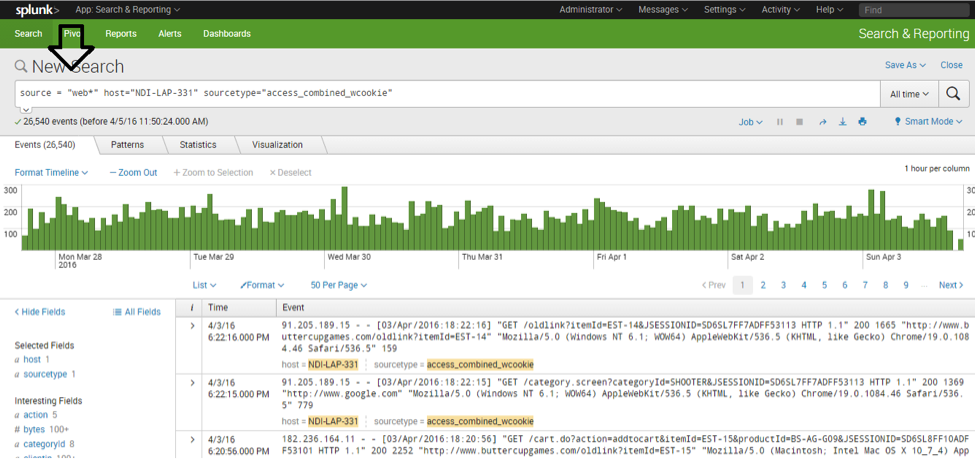

Results area: This shows the events from your search.When Splunk executes a search and field discovery is on, Splunk attempts to identify fields automatically for the current search. Field discovery switch: Turns automatic field discovery on or off.This menu also allows you to add a field to the results. Fields sidebar: Relevant fields along with event counts.Timeline: A graphic representation of the number of events matching your search over time.For example, entering an asterisk (*) in the search bar retrieves all the data in your default indexes. When a search is kicked off, the results almost immediately start displaying. If you click the Search option or enter a search in the search bar, the page switches to the Search dashboard (sometimes called the timeline or flashtimeline view). Interested in learning Splunk? Enroll in our Splunk Training now! The Search Dashboard Searches & Reports lists your saved searches and reports.Dashboards & Views list your dashboards and views.Status lists dashboards on the status of your Splunk instance.Search leads to the main search interface, the Search dashboard.Search navigation menus near the top of the page include:. The Hosts panel shows which host your data came from.The Source types panel shows the types of sources in your data.

The Sources panel shows which files (or other sources) your data came from.

The next three panels show the most recent or common values that have been indexed in each category:

The time range picker to the right of the search bar permits time range adjustment.The search bar at the top is empty, ready for you to type in a search.If you’re on the Splunk Home tab, click Search under Your Apps. Click the Launch search app on the Splunk Welcome tab. The Summary dashboard gives you a quick overview of the data visible to you. Splunk Installation is the first step to the goal of searching with Splunk. It can mean filtering, summarizing, and visualizing a large amount of data, to answer your questions about the data. If you create custom queries, be careful with the placement of quotation marks.The goal of search is to help you find exactly what you need. IMPORTANT: Do not change the quotation marks in these examples or the queries will not work. Replace the template parameters $executor1, $framework2, and any others with actual values from your cluster. Here are example query templates for aggregating the DC/OS logs with Splunk. Search for all of the events that reference the framework ID of the event shown in the screenshot above, but that do not contain the chosen framework field. This will show all of the fields extracted from the task log file path:įigure 2. This will show all of the events where the framework field is defined:Ĭlick the disclosure triangle next to one of these events to view the details. In the Splunk web interface, type framework=* into the Search field. The agent, framework, executor, and run fields should now be available to use in search queries and appear in the fields associated with Mesos task log events. Run the following search in the Splunk Web interface to ensure the changes take effect: extract reload=true The agent, framework, executor, and run fields should now be available to use in search queries and appear in the fields associated with Mesos task log events.Īdd the following entry to nf (see the Splunk documentation for details): ĮXTRACT = /var/lib/mesos/slave/slaves/(?+)/frameworks/(?+)/executors/(?+)/runs/(?+)/.* in source In the Field Extractions view, find the extraction you just created and set the permissions appropriately. Extraction/Transform: /var/lib/mesos/slave/slaves/(?+)/frameworks/(?+)/executors/(?+)/runs/(?+)/.* in source.Apply to source named /var/lib/mesos/slave/.Name: dcos_task (or any unique, meaningful name for the extraction).Navigate to Settings -> Fields -> Field Extractions -> New. You can configure Splunk either by using the Splunk Web interface or by editing the nf file. A Splunk installation that aggregates DC/OS logs.You can use this information to filter the log output for specific tasks, applications, or agents. The file system paths of DC/OS task logs contain information such as the agent ID, framework ID, and executor ID.


 0 kommentar(er)
0 kommentar(er)
